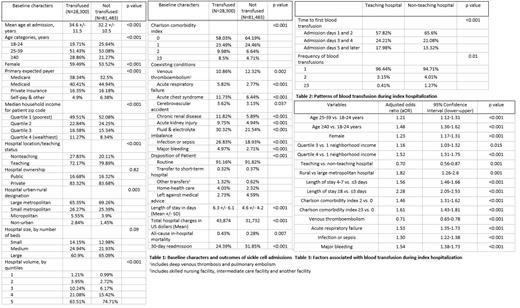Abstract
Background: Transfusional iron overload contributes to considerable morbidity and mortality in patients with sickle cell disease. Despite FDA (Food and Drug Administration) approval of voxelotor in 2019, it remains underutilized, and RBC (red blood cell) transfusions play a prominent role in managing these patients. Contemporary large-scale epidemiologic data on blood transfusions in sickle cell disease are lacking. This study reports demographics, readmission rate, and factors associated with blood transfusion in hospitalizations for sickle cell disease.
Methods: We performed a retrospective cohort study using the Nationwide Readmissions Database (NRD) for 2017 & 2018 to identify hospitalizations with the primary diagnosis of sickle disease using appropriate ICD-10-CM (International Classification of Diseases, Tenth Revision, Clinical Modification) codes. These admissions were categorized into those who received blood transfusions and those without blood transfusions. We performed descriptive analysis to compare demographics, hospital characteristics, various comorbid conditions, and complications between the two groups. All-cause 30-day readmission rate was calculated after excluding index admissions from December, deaths during index admissions, and elective readmissions. Multivariable logistic regression was used to adjust for confounders and determine factors associated with RBC transfusion. The analysis was carried out to produce national estimates after applying weights, and the methodology provided by the HCUP (Healthcare Cost and Utilization Project) was utilized.
Results: Out of 109,783 weighted index hospitalizations, 28,300 were transfused, and 81,483 were not transfused. The proportion of females and 40 years & older was higher in the transfused category than not transfused (59.49% vs. 53.52% and 28.86% vs. 21.27% respectively; p<0.001 for both). The wealthiest population was more likely to be in the transfused category than the non-transfused (11.27% vs. 8.34%; p<0.001). The proportion of admissions to teaching hospitals, large metropolitan hospitals, and highest volume hospitals was higher in the non-transfused category compared to the transfused (79.89% vs. 72.17%; p<0.001, 69.26% vs. 65.35%; p 0.003 and 74.71% vs. 63.51%; p<0.001 respectively). The comorbidity burden, mean length of stay, total hospital charges, and inpatient mortality were higher in the transfused category than those without transfusion (table 1). Most admissions were transfused once, with multiple transfusions (3 or more) being given more in the non-teaching hospitals than teaching (1.27% vs. 0.41%; p 0.01). Furthermore, more than half of all transfusions happened within the first two days of admission, with a higher proportion of early transfusions in the non-teaching hospitals compared to teaching hospitals (65.6% vs. 57.82% for admission days 1 and 2; p<0.001) (table 2). Age group ≥40 years and 25-39 years were more likely to receive transfusion in the first two days of admission than the 18-24-year-olds (69.01% vs. 59.14% vs. 49.2%; p<0.001 respectively). After adjusting for confounders, older age groups (age ≥40 years and 25-39 years) compared to 18-24-year-olds (aOR {adjusted odds ratio} 1.48; 95% CI {confidence interval} 1.36-1.62 and aOR 1.21; 95% CI 1.12-1.31 respectively), female sex (aOR 1.23; 95% CI 1.17-1.31), highest community-level income (aOR 1.52; 95% CI 1.31-1.75), admission to rural hospital (aOR 1.82; 95% CI 1.26-2.6), length of stay 4-7 vs. ≤3 days (aOR 1.56; 95% CI 1.46-1.66) and length of stay ≥8 vs. ≤3 days (aOR 2.28; 95% CI 2.05-2.53) were found to be associated with higher odds of blood transfusion. Admission to a teaching hospital was associated with lower blood transfusion odds than a non-teaching hospital (aOR 0.70; 95% CI 0.56-0.87) (table 3).
Conclusion: A quarter of admissions for sickle cell disease receive a blood transfusion. In addition to performing more frequent and early transfusions, the odds of being transfused are higher in a non-teaching hospital.
No relevant conflicts of interest to declare.


This feature is available to Subscribers Only
Sign In or Create an Account Close Modal